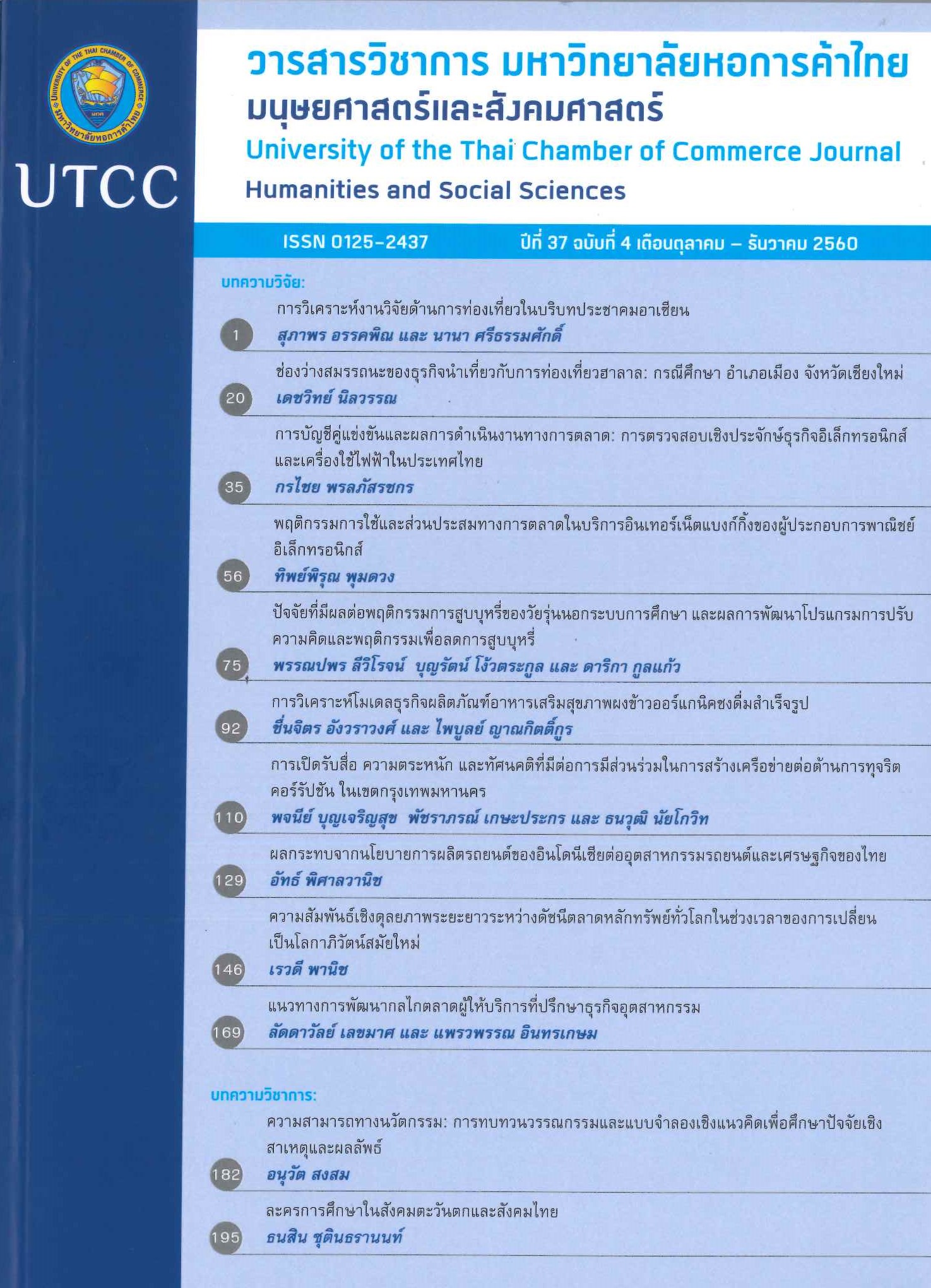Factors Affecting Smoking BehFavior of Out-ofSchool Adolescents and the Effectiveness of Development Program of Cognitive Behavior Therapy to Reducing Smoking Behavior
Main Article Content
Abstract
This study’s objectives are to investigate factors affecting adolescents’ smoking behavior and the effectiveness of the development program of cognitive behavior therapy for reducing smoking behavior among out-of-school adolescents. Research uses mixed methodology of a survey and an experimental design in two phases. The results from the survey is used to develop program of cognitive behavior therapy for reducing the smoking behavior. The research tools include questionnaire and the development program to reduce smoking behaviors. In the first phase, data from 600 adolescents are collected using a questionnaire. The sample comprises 91 out-of-school smokers. The experimental research is derived from the Fagerstrom test for nicotine dependence (FTND) The scores from questionnaire ranges from 4 to 5 indicated the risk of smoking behavior in the total number of 34 smokers. Twenty persons recruited to participate in two groups. The first-10-persons group is called the controlled group and the second-10-person group is called the experimental group. Both groups should attend the activities provided and observed the pre-test, post-test and follow-up tests. Analyses were executed using descriptive statistics, multiple regression technique, and t-test. Research findings show that two key variables, familyfactors and social norms, are significantly related to smoking behaviors. Therefore, these variables are taken to develop the program in phase two of the study. The therapy program developed by applying family factors and social norms in combination with the cognitive behavior therapy of Beck (1967) and future orientation. It comprises 3 steps, 8 activities, 8 times, 60-90 minutes for each, once a week and continuously for 10 weeks. The experimental results demonstrate the effectiveness of the developed CBT program to reducing smoking behaviors.
Article Details
ลิขสิทธิ์ของบทความ
ผลงานที่ได้รับการตีพิมพ์ถือเป็นลิขสิทธิ์ของมหาวิทยาลัยหอการค้าไทย ห้ามมิให้นำเนื้อหา ทัศนะ หรือข้อคิดเห็นใด ๆ ของผลงานไปทำซ้ำ ดัดแปลง หรือเผยแพร่ ไม่ว่าทั้งหมดหรือบางส่วนโดยไม่ได้รับอนุญาตเป็นลายลักษณ์อักษรจากมหาวิทยาลัยหอการค้าไทยก่อน
References
Beck, T. (1995). Cognitive therapy: Basics and beyond. New York, NY: Guilford Press.
Beck, T. (1967). Depression: Clinical, experimental and theoretical aspects. New York, NY: Haper & Row.
Center for Disease Control and Prevention. (2015). Smoking and tobacco use: Fast facts. Retrieved June 12, 2016, from https://www.cdc.gov/tobacco/data_stati
Department of Disease Control, Office of Tobacco Control. (2017). Tobacco products control act (2017). Bangkok, Thailand: Thammasat printing house. (in Thai).
Department of Disease Control, Office of Tobacco Control. (2016). Tobacco consumption control situation in Thailand. Bangkok, Thailand: Thammasat printing house. (in Thai).
Doubeni, M. D., Wenjun, L., Hassan, M. S., & Difranza, R. (2008). Perceived accessibility as a predictor of youth smoking. Ann Family Medicine, 6(4), 323-330.
Edmonds, W. A., & Kennedy, T. D. (2013). An applied reference guide to research designs. Los Angeles, CA: SAGE.
Fagerstrom, K. (1978). Measuring degree of physical dependence to tobacco smoking with reference to individualization of treatment. Addictive Behaviors, 3(3–4), 235–241.
Green, L. W., & Kreuter, M. W. (2005). Health program planning an educational and ecological approach. New York, NY:Quebecor World Fairfield.
Hill, K., Hawkins, D., Catalano, R., Abbott, R., & Guo, J. (2005). Family influences on the risk of daily smoking initiation. Journal of Adolescent Health, 37, 202-210.
Homsin, P. (2007). Smoking initiation among adolescents. The Journal of Faculty of Nursing Burapha University, 15(4), 27-36. (in Thai).
Johnston, D., O’Malley, M., Bachman, G., Schulenberg, E., & Miech, A. (2014). Monitoring the future national survey results on drug use. The University of Michigan, 1, 1975-2011.
Kabir, M. A., & Goh, K. (2013). Determinants of tobacco use among students aged 13-15 years in Nepal and Sri Lanka: Results from the Global Youth Tobacco Survey, 2007. Health Education Journal, 1(1), 1- 11.
Iamanan, P. (2013). Academic information on cigarettes is the same as drugs. Retrieved June 12, 2016, from file:///C:/Users/ Administrator/Download (in Thai).
Morrison, A. (2011). Parental, peer, and tobacco marketing influences on adolescent smoking in South Africa. (Unpublished master’s Thesis). Retrieved June 12, 2016,
from https://scholarworks.gsu.edu/iph_theses/200
National Statistical Office. (2014). The smoking and drinking behavior survey 2014. Bangkok: Social Statistics Group. (in Thai).
Ottaway, A. K. C. (1966). Learning through group experiences. London: Knowledge and kogan.
Page, M., Nguyen, H., Hoang, C., & Truong, T. (2014). Social normative beliefs about smoking among vietnamese adolescents. Asia Pacific Journal of Public Health, 24(1), 68-81.
Prachuabmoh, W. (2012). Demographic and socioeconomic links to smoking. Smart Journal, 13(4),146. (in Thai).
Reangsing, C. (2013). Caring for Adolescents Smoking. Journal of The Royal Thai Army Nurses, 14(2), 17-24. (in Thai).
Rise, J. (2007). The Relation between past behavior, intention, planning, and quitting smoking: The moderating effect of future orientation. Journal of Applied Biobehavioral Research, 12(2), 82-100.
Robbins, R. N., & Bryan, A. (2004). Relationships between future orientation, impulsive sensation seeking and risk behavior among adjudicated adolescents. Journal of Adolescent Health, 19(4), 428-445.
Rogacheva, A., Laatikainen, T., Patja, K., Paavola, M., Tossavainen, K., & Vartiainen, E. (2008). Smoking and related factors of the social environment among
adolescents in the Republic of Karelia, Russia in 1995 and 2004. The European Journal of Public Health, 18, 630-636.
Sirirassamee, P., Guest, P., Sirirassamee, T., Pholprasert, V., Pitakmahaket, O., & Kenroj, P. (2007). The effect of tobacco control policy and adolescents survey in Thailand
for Wave 2 (2006). Nakhon Pathom, Thailand: Mahidol University, Institute for Population and Social Research. (in Thai).
Steinberg, L. (2012). Adolescent decision making and the prevention of underage smoking. Psychobiology, 5(2), 316-324.
Tobacco Control Research and Knowledge Management Center. (2008). A survey of smoking behaviors among Thai adolescents 1992-2007. Retrieved June 12, 2016, from https://www.trc.or.th (in Thai).
Umaru, Y., Abdullahi, M.I., Oliagba, O., & Sambo, S. (2014). The effect of cognitive restructuring intervention on tobacco smoking among adolescence in senior secondary school in Zaria Kaduna State Nigeria. European Scientific Journal, 10(5), 922-944.
Vateesatokkij, P., Chiratanon, S., Pichayakulmongkol, C., & Salanond, S. (2010). Ready. Not a victim. Bangkok, Thailand: Action on Smoking and Health Foundation, Thai Health Promotion Foundation. (in Thai).
World Health Organization. (2013). Tobacco use. Retrieved June 12, 2016, from https://www.who.int

